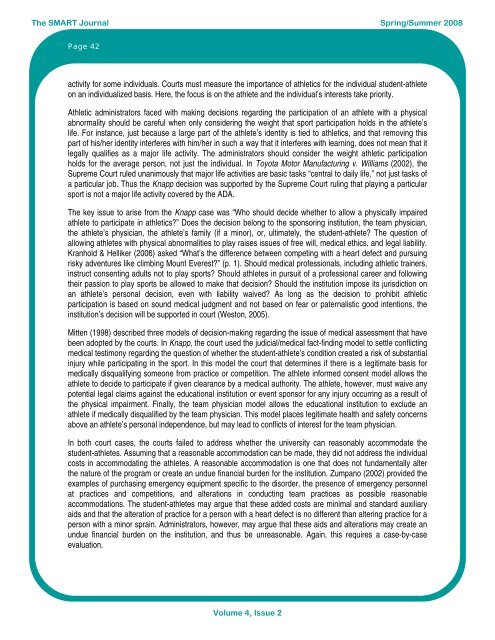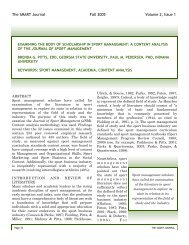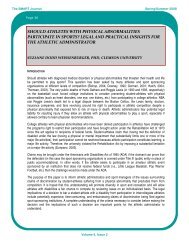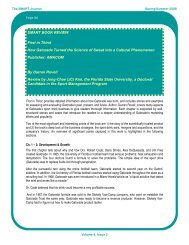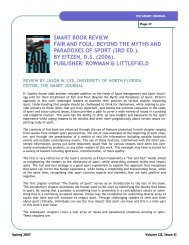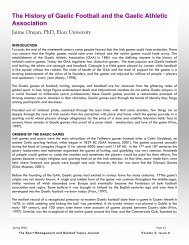Spring/Summer 2008 Volume 4, Issue 2 - The SMART Journal
Spring/Summer 2008 Volume 4, Issue 2 - The SMART Journal
Spring/Summer 2008 Volume 4, Issue 2 - The SMART Journal
Create successful ePaper yourself
Turn your PDF publications into a flip-book with our unique Google optimized e-Paper software.
<strong>The</strong> <strong>SMART</strong> <strong>Journal</strong> <strong>Spring</strong>/<strong>Summer</strong> <strong>2008</strong><br />
Page 42<br />
activity for some individuals. Courts must measure the importance of athletics for the individual student-athlete<br />
on an individualized basis. Here, the focus is on the athlete and the individual’s interests take priority.<br />
Athletic administrators faced with making decisions regarding the participation of an athlete with a physical<br />
abnormality should be careful when only considering the weight that sport participation holds in the athlete’s<br />
life. For instance, just because a large part of the athlete’s identity is tied to athletics, and that removing this<br />
part of his/her identity interferes with him/her in such a way that it interferes with learning, does not mean that it<br />
legally qualifies as a major life activity. <strong>The</strong> administrators should consider the weight athletic participation<br />
holds for the average person, not just the individual. In Toyota Motor Manufacturing v. Williams (2002), the<br />
Supreme Court ruled unanimously that major life activities are basic tasks “central to daily life,” not just tasks of<br />
a particular job. Thus the Knapp decision was supported by the Supreme Court ruling that playing a particular<br />
sport is not a major life activity covered by the ADA.<br />
<strong>The</strong> key issue to arise from the Knapp case was “Who should decide whether to allow a physically impaired<br />
athlete to participate in athletics?” Does the decision belong to the sponsoring institution, the team physician,<br />
the athlete’s physician, the athlete’s family (if a minor), or, ultimately, the student-athlete? <strong>The</strong> question of<br />
allowing athletes with physical abnormalities to play raises issues of free will, medical ethics, and legal liability.<br />
Kranhold & Helliker (2006) asked “What’s the difference between competing with a heart defect and pursuing<br />
risky adventures like climbing Mount Everest?” (p. 1). Should medical professionals, including athletic trainers,<br />
instruct consenting adults not to play sports? Should athletes in pursuit of a professional career and following<br />
their passion to play sports be allowed to make that decision? Should the institution impose its jurisdiction on<br />
an athlete’s personal decision, even with liability waived? As long as the decision to prohibit athletic<br />
participation is based on sound medical judgment and not based on fear or paternalistic good intentions, the<br />
institution’s decision will be supported in court (Weston, 2005).<br />
Mitten (1998) described three models of decision-making regarding the issue of medical assessment that have<br />
been adopted by the courts. In Knapp, the court used the judicial/medical fact-finding model to settle conflicting<br />
medical testimony regarding the question of whether the student-athlete’s condition created a risk of substantial<br />
injury while participating in the sport. In this model the court that determines if there is a legitimate basis for<br />
medically disqualifying someone from practice or competition. <strong>The</strong> athlete informed consent model allows the<br />
athlete to decide to participate if given clearance by a medical authority. <strong>The</strong> athlete, however, must waive any<br />
potential legal claims against the educational institution or event sponsor for any injury occurring as a result of<br />
the physical impairment. Finally, the team physician model allows the educational institution to exclude an<br />
athlete if medically disqualified by the team physician. This model places legitimate health and safety concerns<br />
above an athlete’s personal independence, but may lead to conflicts of interest for the team physician.<br />
In both court cases, the courts failed to address whether the university can reasonably accommodate the<br />
student-athletes. Assuming that a reasonable accommodation can be made, they did not address the individual<br />
costs in accommodating the athletes. A reasonable accommodation is one that does not fundamentally alter<br />
the nature of the program or create an undue financial burden for the institution. Zumpano (2002) provided the<br />
examples of purchasing emergency equipment specific to the disorder, the presence of emergency personnel<br />
at practices and competitions, and alterations in conducting team practices as possible reasonable<br />
accommodations. <strong>The</strong> student-athletes may argue that these added costs are minimal and standard auxiliary<br />
aids and that the alteration of practice for a person with a heart defect is no different than altering practice for a<br />
person with a minor sprain. Administrators, however, may argue that these aids and alterations may create an<br />
undue financial burden on the institution, and thus be unreasonable. Again, this requires a case-by-case<br />
evaluation.<br />
<strong>Volume</strong> 4, <strong>Issue</strong> 2


